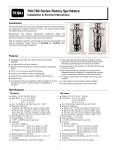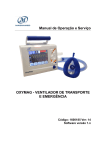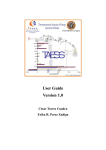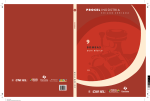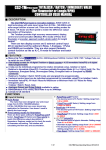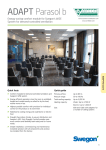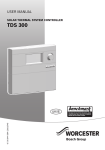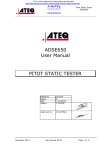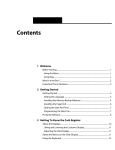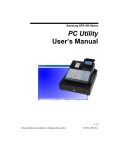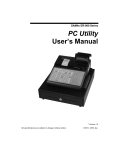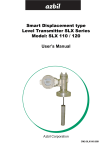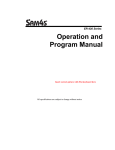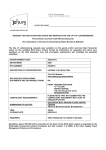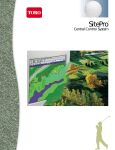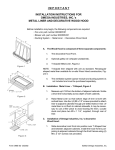Download User Manual
Transcript
ELKHART BRASS MFG. CO., INC. 1302 WEST BEARDSLEY AVENUE • P.O. BOX 1127 • ELKHART IN 46515 • (574) 295-8330 • FAX (574) 293-9914 Installation, Operating, & Maintenance Instructions 8494 Monitor 98429000 REV. C SYSTEM INFORMATION: MONITOR SERIAL NUMBER: ___________________________________________ MONITOR ACCESSORIES (NOZZLE GALLONAGE AND TYPE, TYPES OF TRANSMITTERS, WATER VALVE (Y/N), ETC.): _______________________________________________________________ _______________________________________________________________ _______________________________________________________________ _______________________________________________________________ _______________________________________________________________ _______________________________________________________________ _______________________________________________________________ _______________________________________________________________ TABLE OF CONTENTS I. PRODUCT SAFETY ...................................................................................................1 II. SYSTEM COMPONENT DESCRIPTIONS ....................................................................3 A. B. C. RF Monitor.................................................................................................. 3 RF Receiver/Control Module ............................................................................................... 3 RF Transmitters..................................................................................................................... 4 1. Primary Transmitter .......................................................................................................... 5 2. Secondary Hand Held Transmitter ................................................................................. 6 D. 5000 Series Nozzles............................................................................................................. 6 E. 81181501 Water Valve Kit (Optional) ................................................................................ 7 F. SM-10FE De/Anti-Icing Nozzle ........................................................................................... 7 III. CONTROL SYSTEM SPECIFICATIONS .......................................................................8 IV. INSTALLATION INSTRUCTIONS .................................................................................9 A. 1. 2. 3. 4. B. C. V. Component Mounting ........................................................................................................... 9 RF Monitor .................................................................................................. 9 RF Receiver/Control Module Wiring ............................................................................ 10 Joystick Control Box ....................................................................................................... 11 81181501 Water Valve Kit (Optional) .......................................................................... 11 RF Settings .......................................................................................................................... 13 Left/Right Rotation Envelope Programming ................................................................... 14 OPERATING INSTRUCTIONS ...................................................................................16 A. 1. 2. B. C. VI. Normal Operation................................................................................................................ 16 81498001 Joystick Transmitter ..................................................................................... 16 81502001 Handheld Transmitter .................................................................................. 16 Oscillation Function ............................................................................................................ 17 Manual Override.................................................................................................................. 18 MAINTENANCE .......................................................................................................19 A. B. C. Preventive Maintenance .................................................................................................... 19 Understanding the RF Receiver/Control Module Circuit Board LEDs ........................ 19 Handheld Transmitter ......................................................................................................... 20 1. Battery Type..................................................................................................................... 20 2. Replacing the Batteries .................................................................................................. 20 VII. MONITOR & NOZZLE HYDRAULIC DATA ................................................................21 VIII. PARTS DRAWINGS..............................................................................................24 I. PRODUCT SAFETY Important: Before installing and operating this equipment, read & study this manual thoroughly. Proper installation is essential to safe operation. In addition, the following points should be adhered to in order to ensure the safety of equipment and personnel: 1. All personnel who may be expected to use this equipment must be thoroughly trained in its safe and proper use. 2. Before flowing water from this device, check that all personnel (fire service and civilian) are out of the stream path. Also, check to make sure stream direction will not cause avoidable property damage. 3. Become thoroughly familiar with the hydraulic characteristics of this equipment, and the pumping system used to supply it. To produce effective fire streams, operating personnel must be properly trained. 4. Whenever possible, this equipment should be operated from a remote location. Do not needlessly expose personnel to dangerous fire conditions. 5. Open water valve supplying this equipment slowly, so that the piping fills slowly, thus preventing possible water hammer occurrence. 6. After each use, and on a scheduled basis, inspect equipment per instructions in section VI. 7. Any modifications to the electrical enclosures will destroy the NEMA 4 rating and void warranty coverage of the enclosure and all components within. Page 1 Figure 1 8494 Monitor Page 2 II. A. SYSTEM COMPONENT DESCRIPTIONS RF Monitor The RF Monitor is specially designed for use on off-road or wild land fire RF is controlled from inside the cab through a wireless fighting apparatus. The transmitter or by handheld transmitter so risk to firefighters is significantly reduced. The RF features durable Elk-O-Lite® construction combined with rugged, stainless steel gears and motors that are completely enclosed and sealed for maximum protection from the elements. The RF has a flow efficient 2.0” vaned waterway to minimize turbulence and provide superior fire streams. Water supply is provided through the monitor base by 2” National Pipe Thread connection. The discharge nozzle connection is a 1½” National Hose Thread. Nozzle stream direction is controlled by two permanent magnet type gear motors, one controlling rotation about the axis of the water inlet, and the other controlling nozzle elevation and depression. An optional 2.0” electric valve kit is available to allow the user to control water flow directly from the RF control box. This enables “pump and roll” functionality with complete control by the operator in the cab of the truck via wireless joystick control. The electric valve can also be controlled using the optional handheld wireless transmitter. B. RF Receiver/Control Module The monitor control circuit uses a state-of-the-art PIC (Programmable Integrated Circuit) chip design. This device allows numerous control features while keeping circuit board size to a minimum. Relays within this box provide motor reversing control for the Up/Down, Left/Right, valve Open/Close and nozzle Straight Stream/Fog functions. All functions are sent to the RF receiver/control module via an encoded radio frequency link. The radio link reduces the number of control wires down to just the two power leads, dramatically simplifying the installation procedure. The link also allows wireless control from up to ¼ mile away using a battery powered handheld transmitter. A rotary pulse counter, part of the horizontal motor, provides horizontal motion control feedback. The counter in combination with the PIC controller enables the monitor to move between programmable endpoints that are programmed by the user for rotation up to 360°total (+/- 180° from center). This feature also allows the unit to be programmed to oscillate between positions within the total travel setting. This feature can be programmed easily with any of the wireless transmitters. No mechanical stops to adjust. The control circuit also provides secondary motor protection with the use of electronic current sensing circuitry. If the monitor encounters an obstruction before reaching a pre-set limit, this circuitry quickly senses motor stall current and automatically shuts off power to the motor. As soon as the control switch is released, the circuit resets to allow subsequent operation of the monitor. Page 3 Figure 2 81496001 RF Receiver/Control Module Caution: Any modification of the enclosure will destroy the NEMA 4 rating, and will void the warranty coverage of the RF Receiver/Control Module. The following additional functions/features are provided in the RF receiver/control module: Reverse Polarity Protection: If battery connections are reversed, this feature prevents power from being applied to circuits, and prevents damage to electronic components. Circuit Board Moisture Protection: In addition to being protected within a NEMA 4 sealed enclosure, the circuit board and circuit components are protected from moisture by an acrylic resin conformal coating. C. RF Transmitters The 8494 RF monitor uses W.E.T. (Wireless Electronic Technology), an innovative wireless radio link, to send all commands from the RF transmitters to the RF Receiver/Control Module. The new W.E.T. wireless link gives the operator the ability to view the discharge stream and target from virtually any point of view. The 8494-RF monitor comes standard with a joystick or a twin joystick transmitter. An optional handheld transmitter can be purchased from Elkhart Brass and can be programmed to work with any W.E.T. enabled monitor. Page 4 1. Primary Transmitter The Sidewinder RF has two joystick transmitter options. Either joystick transmitter can be used and will override the handheld transmitter. 81498001 Joystick Transmitter (Figure 3) The RF joystick is suitable for mounting inside the apparatus cab. The joystick controls all four monitor functions plus oscillation. Up/Down and Left/Right monitor functions can be operated simultaneously. The water valve is controlled with a trigger switch on the front of the joystick. The water valve can also be locked open by activating the button located on the enclosure top. Nozzle pattern is changed using the rocker switch on the top of the joystick. The monitor direction is changed by moving the joystick in the desired direction. Oscillation is programmed by using the joystick in conjunction with the oscillate button. Figure 3 81498001 Joystick Transmitter Caution: Joysticks are not environmentally sealed. only. Use outside of cab will void the warranty coverage. Page 5 They are meant for in cab use 2. Secondary Hand Held Transmitter 81502001 Handheld Transmitter (Figure 4) A sealed handheld remote contains all the controls necessary for operation of the monitor, oscillation, nozzle, and water valve. The handheld remote allows the operator to direct the monitor from a significantly improved point of view. With the wireless remote, the operator can view the stream from the side and confirm it is hitting the target. Separate push button switches are provided for up, down, left, right, fog, stream, valve open, and valve close functions. The handheld remote has user selectable frequency and security codes that allow multiple monitors to operate on the same fire ground at the same time. The remote has an automatic power down feature that will shut down the power after 5 minutes of no activity. As an additional power saving feature, the radio signal is only transmitted while a button is pushed. The handheld remote case has a NEMA 4 rating. Figure 4 81502001 Handheld Transmitter Caution: Any modification of the enclosure of the handheld transmitter will destroy the NEMA 4 rating, and will void the warranty coverage of the remote control. D. 5000 Series Nozzles Three constant flow electric nozzles are offered with the RF monitor with flows ranging from 15 to 350 GPM. The nozzle pattern is electrically actuated and controlled by the monitor control box. The 5000-04 Series nozzles have a flush feature to clear debris from the nozzle without shutting down the water flow. 5000-04; 15, 30, or 45 GPM 5000-14; 60, 95, 125, or 150 GPM 5000-24; 175, 200, 250, or 350 GPM Figure 5 5000-24 Electrically Actuated Nozzle Page 6 E. 81181501 Water Valve Kit (Optional) The RF water valve kit provides a convenient remote on-off control of the water supply to the 8494 RF. This allows the operator complete control of the unit from the safety of the vehicle cab or radio handheld transmitter. The water valve motor speed prevents water hammer, yet closes quickly enough to help preserve the limited on-board water supply. Figure 6 2920E Electrically Actuated Valve F. SM-10FE De/Anti-Icing Nozzle Designed for the aircraft deicing industry, this nozzle has been designed for use with type 1 de-icing, type 2 antiicing, or type 4 anti-icing fluids. The SM-10FE has Viton® O-rings to withstand the use of the Ethylene Glycol and Propylene Glycol solutions used to de-ice aircraft. The nozzle is constant gallonage at pressures below 90 Psi and becomes automatic at 95 Psi. It is designed to deliver 20 GPM at 50 Psi and 30 –120 GPM from 90-110 Psi. Figure 7 SM-10FE De/Anti-Icing Nozzle Page 7 III. CONTROL SYSTEM SPECIFICATIONS Handheld Transmitter Specifications • • Input power Output power • • • • Transmitter dimensions Transmitter weight Operating temperature range FCC ID 2 AA batteries (Alkaline recommended) Meets FCC part 15 requirements for license free operation 6” x 3 1/4” x 1 3/8” 10 ½ oz. -40°F to 150°F (-40°C to 65°C) QT8PTSS2003 Fixed Transmitter Specifications • • Input power Output power • • • Transmitter dimensions Operating temperature range FCC ID 12/24 VDC (11VDC to 27 VDC) Meets FCC part 15 requirements for license free operation Joystick: 4 3/4” x 4 11/16” x 10 5/8” -40°F to 150°F (-40°C to 65°C) QT8PTSS2003 RF Receiver/Control Module Specifications • • • • 12VDC (11VDC to 14VDC) 16 1/4” x 10 1/2” x 3 3/16” 0.15 A* -40°F to 176°F (-40°C to 80°C) Power requirements RF Receiver/Control Module dimensions Control current Operating temperature range Table 1 Motor Current Specifications Monitor Run I Stall I Current Trip Point Left/Right 2A 12 A 9.2 A Up/Down 2A 14 A 8A Nozzle 0.5 A NA 4A Shock: • 30 G's (55 Hz. @ .2 inch double amplitude) Vibration: • 15.5 G's (55 Hz. @ .05 inch double amplitude) continuous operation Drop Test: • Both the transmitter and RF receiver/control module must meet operating specifications after drop from 1-meter height onto concrete surface. Environmental: • * NEMA 4 rating (except 81498001 Joystick Assembly) (must withstand a 1 inch stream of water (65 gpm) from a distance of ten feet for five minutes, with no water entering the enclosure). All current ratings are at 12 volts Page 8 IV. INSTALLATION INSTRUCTIONS A. Component Mounting 1. RF Monitor RF monitor, ensure that both the horizontal and vertical Before mounting the rotation envelopes are clear of all obstructions. See Figure 8 and Figure 9 for envelope dimensions. The left-right rotation limits are programmable. [They are factory set at 180° (+/- 90° from zero position)]. Caution: Using the manual override feature will alter the programmed travel limits when used when the left-right motor is not powered. This could cause possible damage to the vehicle or monitor unit. 1) Ensure the left-right and up-down motors are aligned as shown in Figure 8. This is zero position. 2) Ensure that all of the electrical connections have been disconnected. 3) Tighten the Sidewinder® RF monitor to a securely mounted 2.0” NPT (additional support may be necessary). The monitor can be mounted in any orientation, although some orientations will reverse the directions of movement relative to the function labeling on the transmitter(s). Apply a suitable thread sealant, thread the monitor onto the pipe connection, and tighten it securely with a strap wrench. Do not use motors or discharge as a lever to tighten monitor. Make sure the motor on the monitor base is facing away from the intended center of rotation. Harness will not allow monitor to rotate more than 180° from zero position for a total 360° rotation. 4) Reconnect the electrical connections according to Figure 12. Check all of the electrical connections to make sure they are tight. Allow enough slack in the monitor harness to permit travel to the limits allowed by the RF Receiver/Control Module without straining the wires. Warning: The harness is not designed for continuous 360° rotation. The monitor will travel more than 360° if travel limits are not programmed. Be sure travel limits are programmed to prevent damage from over traveling. ZERO POSITION 90 O FACTORY SETTING 90 O 90 O FACTORY SETTING R12.63 45 O 180 MAX O 180 MAX O Figure 8 Programmable Left-Right Rotation Envelope Page 9 Figure 9 Up-Down Rotation Envelope 2. RF Receiver/Control Module Wiring 1) Place a 10A fuse between the red lead of the RF Receiver/Control Module power connector and a switched positive power lead on the vehicle. Attach the black lead from the RF Receiver/Control Module power connector to the vehicle ground. 2) All control functions are sent to the monitor via an encoded RF signal from the transmitter; no control wiring is needed. 3) Mark the mounting screw pattern per dimensions in Figure 10. 4) Drill four ∅0.203” (13/64” drill) holes. 5) Secure the unit to the panel with four #10-32 screws with nuts and lock washers (not supplied). The length of the screws should be the panel thickness plus 3/8” minimum. Figure 10 81496001 RF Receiver/Control Module Mounting Layout Page 10 Figure 11 81498001 Joystick Transmitter Mounting Layout 3. Joystick Control Box 1) Mark the mounting screw pattern per dimensions in Figure 11. 2) Drill four ∅0.203” (13/64” drill) holes. 3) Secure the unit to the panel with four #10-32 screws with nuts and lock washers (not supplied). The length of the screws should be the panel thickness plus 3/8” minimum. 4) Place a 1A fuse between the red lead of the transmitter and a switched positive power lead on the vehicle. Attach the black lead from the monitor base to the vehicle ground. 5) All control functions are sent to the monitor via an encoded RF signal from the transmitter. 4. 81181501 Water Valve Kit (Optional) Install the valve inline with the RF monitor. Install power/sensor cable between RF Receiver/Control Module and valve. The cables should be routed away from any heat sources, and be protected from sharp corners. It should be tied down securely to prevent fretting or fraying due to vehicular vibrations. Two cable lengths (five foot [standard] and 10 feet [optional]) are available for the valve to allow it to be mounted in a convenient location. Connect the motor power and sensor lead to the valve harness. Page 11 MONITOR 8494 RF MONITOR HARNESS 5 FT STANDARD (10 FT OPTIONAL) RECEIVER/CONTROL MODULE HARNESS FOR OPTIONAL WATER VALVE 5 FT STANDARD (10 FT OPTIONAL) TRUCK POWER 11-14 VDC 8 AMP CONT. 11 AMP PEAK 10 AMP FUSE HANDHELD TRANSMITTER 2 AA BATTERIES OPTIONAL WATER VALVE JOYSTICK TRANSMITTER TRUCK POWER 11-27 VDC 1 AMP PEAK 5 AMP FUSE Figure 12 8494 RF 12VDC Layout Page 12 B. RF Settings Caution: The RF Receiver/Control Module and all transmitters’ communication addresses have been set at the factory. They should not require any additional address settings. The left-right rotation envelope has been set at the factory for 360° (+/- 180° from center). If an alternate rotational envelope is desired or if manual override is used without power provided to the left-right motor, see section IV.C Left/Right Rotation Envelope Programming for reprogramming of the left-right rotation envelop. A RF transmitter controls the 8494 RF monitor. The transmitter uses a security code to ensure that it does not accidentally control the wrong monitor. The RF Receiver/Control Module verifies the security code and then interprets commands. The security code is a 15bit selectable code that is set on both the transmitter and the RF Receiver/Control Module. The 8494 RF monitor is tested and shipped with a security code based upon the monitor serial number, ensuring each monitor leaves the factory with a unique code assigned to it. The security settings will normally not need to be changed. In cases where a replacement transmitter, new transmitter, or RF Receiver/Control Module circuit board is needed, Elkhart Brass will require the 8494 RF monitor’s serial number. This allows the address to be set at the factory on the new unit. Danger: DO NOT attempt to set two or more systems with identical addresses. Using two W.E.T. monitors with the same, security code may cause the inadvertent control of the wrong monitor, resulting in possible property damage and injury to personnel. Using the factory specified codes will prevent this problem. Page 13 Red Programming Button A B Status LED Figure 13 24263001 RF Receiver/Control Module Circuit Board Layout C. Left/Right Rotation Envelope Programming The 8494 RF monitor is set with a 180° (+/- 90° from center) left/right rotation envelope. The up/down travel limits are provided by magnets placed in the monitor at assembly and are not adjustable. The range is -45°to 90°. Caution: To prevent damage to the monitor RF Receiver/Control Module, keep all metallic objects away from the circuit board while it is energized. Ensure all O-ring and gaskets are properly installed when closing receiver or controller enclosures. 1) Open the RF Receiver/Control Module enclosure (P/N 81496001). See Figure 2. 2) Supply power to the RF Receiver/Control Module. 3) To program the left/right rotation envelope, perform the following three steps NOTE – All three programming steps must be completed otherwise the changes will not be stored to permanent memory! (1) Press and hold the Red Programming Button (see Figure 13) on the circuit board until the status LED (DS5) flashes 3 times (approximately 8 seconds). Once the LED starts flashing, release the red button. (2) To set the left limit of the travel envelope, run the monitor left until it has reached the desired position. Quickly press and release the Red Programming Button. The status LED will flash once to acknowledge the new travel limit position. Page 14 (3) To set the right limit of the travel envelope, run the monitor right until it has reached the desired position. Quickly press and release the Red Programming Button. The status LED will flash rapidly approximately 8-10 times to acknowledge the new travel limit position as well as the completion of the programming sequence. (4) Replace the RF Receiver/Control Module cover removed earlier. Caution: Left/Right rotation travel envelope should be verified to be correct after programming. If the monitor does not stop at the programmed rotational limit positions then re-program the rotational limits. Checking rotational limits should be part of normal truck maintenance. Caution: Using the left-right override nut when the power to the receiver module is off or the horizontal motor is disconnected will move the horizontal limits from their original programmed positions. Page 15 V. OPERATING INSTRUCTIONS A. Normal Operation 1. 81498001 Joystick Transmitter A. Monitor Control With the 81498001 Joystick Transmitter, the monitor, nozzle, and valve are controlled with the joystick and accompanying switches. Simply push and hold the joystick to move the monitor to the desired stream direction. Release the joystick when the proper stream position is achieved. The nozzle spray pattern is controlled using the rocker switch on the top of the joystick. The controller provides an automatic left-right speed adjustment to allow the user better directional control. During normal operation, the left-right motor will move slowly for about two seconds before accelerating to full speed. This allows the user to be able to position the monitor quickly but also gives the fine control needed to aim the monitor accurately at a distant target. Any combination of left or right and up or down can be used simultaneously. B. Valve Control To flow water for short durations operate the valve with the trigger on the front of the joystick. The valve will remain open as long as the trigger is squeezed. When it is released, the valve will close. To continuously flow water, simultaneously push the lock open pushbutton and squeeze the water valve trigger on the joy stick; once the water valve starts moving the operator may release both switches and the valve will travel to the full open position. To close the valve, push and release either the lock open pushbutton or the water valve trigger on the joystick. 2. 81502001 Handheld Transmitter The 8494 RF Monitor uses the standard Left/Right, Up/Down, and Fog/Stream commands to provide stream direction and pattern adjustments. The transmitter provides an automatic speed adjustment to allow the user better directional control. During normal operation, the left-right motor will move slowly for about two seconds before accelerating to full speed. This allows the user to be able to position the monitor quickly but also gives the fine control needed to aim the monitor accurately at a distant target. To move the monitor left or right, press and hold the left or right button until the monitor discharge is in the correct position. The left-right motor will begin to turn the monitor slowly and then accelerate to full speed after a couple of seconds. If any of the up-down or fog-stream buttons are selected while the left-right motion is in slow speed, the leftright motor will immediately go to high speed until the monitor stops moving. The unit will revert to normal operation when the buttons are released. 1) To move the monitor up or down, press and hold the up or down button until the monitor is in the correct position or an electrical stop is reached. 2) To adjust the stream pattern, press and hold the fog or stream button until the desired stream pattern is reached. Elkhart electric nozzles have a unique ball screw drive which when it reaches the end of travel will continue spinning until the button is released. Page 16 Any combination of left or right and up or down can be used simultaneously. If the left and right buttons are pressed at the same time, the monitor will stop all motion. 3) To open the water valve, push and release the valve open button. The valve will open fully and remain open. To close the valve, push and release the valve close button. The valve will completely close and remain closed. There is no need to wait for the valve to fully open or close before reversing direction. The close button for the water valve on the handheld will disengage the lock open feature of the primary transmitter and close the water valve. This feature allows the operator to exit the vehicle with the water valve locked open and operates the monitor via the handheld. When and if the operate chooses to take over command of the water valve, a push of the close button releases the “lock open” feature and transfers water valve control to the handheld. 4) The handheld transmitter has a power saving feature that turns the transmitter power off if no signal is sent for 5 minutes. Press and hold the “ON/OFF” button until the Power LED illuminates to reactivate the transmitter. The “Low Battery” LED will flash slowly when the battery voltage drops below a predetermined level. When the low battery LED flashes rapidly, the batteries are nearly discharged and should be replaced immediately. B. Oscillation Function The 8494 RF monitor has an oscillation function, which can be used to provide continuous exposure protection with no operator input. The oscillation limits are set using either joystick or handheld transmitters. The motor two-speed feature is turned off during oscillation and the monitor will oscillate back and forth at full speed. Note: The oscillation travel limits must be within the programmed left/right rotation envelope. Page 17 1) Position the monitor at one of the oscillation travel limits. 2) Press and hold the oscillate button. 3) Move the monitor to the other oscillation travel limit and release the direction button 4) Release the oscillate button. 5) Quickly press and release the oscillate button to start the oscillation function. 6) The monitor will oscillate between the programmed limits until the oscillation button is pressed again or initiating a left or right command from any transmitter. 7) Changing up-down position stream setting or operating the water valve will not interrupt the oscillation program. For safety reasons, once oscillation has stopped the oscillation travel limits need to be reprogrammed. See steps 1-7. C. Manual Override In the event of power failure, the monitor, nozzle, and water valve may be actuated manually. To operate a function manually, simply apply a 3/4" ratcheting type wrench (either socket type or ratcheting box end type) to the hex fitting on the motor shaft extension. The override functions can be made much easier if the motor power wire connector is unplugged from the control harness where possible. Caution: Do not use any power tools to operate the manual override nuts. Serious damage to the motor gear heads will result. Using the left/right override nut when the power to the control module is off or the left/right motor is disconnected will move the left-right rotation envelope limits from their original programmed position, which may result in damage to the vehicle and/or monitor. The left/right rotation envelope should be reprogrammed after power has been restored. Page 18 VI. MAINTENANCE A. Preventive Maintenance The complete monitor and control system should be inspected during each apparatus check. Careful inspection for damage to the monitor, valve, or nozzle is especially important after use of the RF Monitor in emergency operations. 1. Operate all possible functions from each control point. 2. Flow water to check the nozzle pattern. If the pattern is disrupted, clear the debris. The 5000-04 nozzle has a flush feature to clear the debris. If the obstruction still remains, remove the nozzle and check for debris lodged between the nozzle stem and body. 3. During nozzle flow test, inspect monitor swivel joints and water valve for leaks. 4. Inspect all exposed wiring for signs of damage. Note: Although grease fittings are provided for the up-down and left-right gear cases, routine greasing should not be necessary. If the monitor is exposed to high level of radiant heat for a prolonged period, it may be possible for the factory grease to thin and run out of the gear cases. In such an event, fresh grease should be applied. It is recommended that Mobilith AW2 grease be used to lubricate the monitor gearing. B. Understanding the RF Receiver/Control Module Circuit Board LEDs LED Notations DS1 (Figure 13) - Lights when either nozzle direction is engaged. DS2 (Figure 13) – Lights when either of the VALVE OPEN/CLOSED buttons are pushed. DS3 (Figure 13) – Comes on when the UP or the DOWN button is depressed. DS4 (Figure 13) – Comes on with any horizontal movement. DS5 (Figure 13) – See Table 2. Table 2 DS5 Status LED (Indication VS. Meaning) Reference 1 Indication On solid when monitor stops 2 Blinks 6 times at 1 second rate during startup 3 Blinks 6 times at 1 second rate during startup then blinks at ¼ second rate continuously Blinks at ½ second rate 4 Page 19 Meaning Motor has reached stall current and performing normal shutdown Visual indication that the controller is initializing – normal operation during power up SW4 (Figure 13) in wrong position – must be in certain positions for proper Sidewinder operation Truck battery voltage <8 volts - light will blink until power is lost or is restored – early power fail (EPF) indication C. Handheld Transmitter 1. Battery Type The 8494 RF handheld transmitter uses two AA batteries. Alkaline batteries are recommended. The low battery light will illuminate with approximately two hours of transmission time remaining before the batteries are completely discharged. Due to the time-voltage characteristics of rechargeable batteries, this time could be drastically reduced if rechargeable batteries are used. 2. Replacing the Batteries The batteries can be replaced with any standard fresh AA alkaline batteries. 1) Turn the transmitter power off. 2) Remove the battery cover. 3) Remove both of the old AA batteries at the same time. 4) Insert the new AA alkaline batteries. 5) Replace the battery cover. Page 20 VII. MONITOR & NOZZLE HYDRAULIC DATA 5000-04 Flow Data (GPM) 15 GPM Stem 9 11 12 15 17 18 20 22 PSI 40 50 75 100 125 150 175 200 30 GPM Stem 20 22 26 30 34 37 39 41 45 GPM Stem 32 35 40 45 49 52 56 58 5000-04 Reach Data (ft) 40 50 75 100 125 150 175 200 15 GPM Stem SS N. FOG W. FOG SS 48 56 58 61 63 65 66 65 70 81 85 90 91 92 20 22 24 26 28 31 32 11 14 15 17 19 21 22 30 GPM Stem N. FOG W. FOG 30 35 41 44 47 48 49 15 16 17 21 23 25 26 SS 69 75 83 91 96 98 101 45 GPM Stem N. FOG W. FOG 32 37 44 46 48 50 51 17 18 21 23 25 26 28 5000-14 Flow Data (GPM) 40 50 75 100 125 150 175 200 60 GPM Stem 38 43 51 60 68 73 79 85 95 GPM Stem 63 68 83 95 107 115 126 134 40 50 75 100 125 150 175 200 60 GPM Stem N. FOG W. FOG 38 31 41 33 44 35 49 41 55 43 61 47 66 51 71 58 125 GPM Stem 82 91 110 125 140 153 165 177 150 GPM Stem 97 107 132 150 169 182 198 212 5000-14 Reach Data (ft) SS 69 76 89 96 104 110 115 124 SS 77 86 101 111 118 126 130 138 95 GPM Stem N. FOG W. FOG 40 29 41 30 46 33 55 36 59 40 64 44 67 47 70 51 SS 78 86 103 113 121 128 138 146 125 GPM Stem N. FOG W. FOG 44 32 48 36 55 37 62 44 67 49 71 52 77 56 84 59 Figure 14 5000-04 and 5000-14 Flow and Reach Data Page 21 SS 80 89 108 124 138 148 156 162 150 GPM Stem N. FOG W. FOG 46 34 51 37 53 43 56 46 58 48 60 51 62 52 64 55 5000-24 Flow Data (GPM) 200 GPM Stem 126 141 173 200 224 245 265 283 175 GPM Stem 111 124 150 175 192 210 231 247 40 50 75 100 125 150 175 200 250 GPM Stem 172 192 230 250 279 306 331 353 350 GPM Stem 220 240 289 325 362 398 429 459 5000-24 Reach Data (ft) 175 GPM Stem SS N. FOG W. FOG 88 47 32 98 51 34 114 59 36 126 69 39 141 76 44 152 81 48 165 88 51 178 95 54 40 50 75 100 125 150 175 200 200 GPM Stem SS N. FOG W. FOG 91 51 34 101 54 36 117 61 40 132 73 44 148 78 48 159 83 52 - 250 GPM Stem SS N. FOG W. FOG 91 53 35 102 56 40 118 62 43 136 75 48 152 79 51 164 83 54 179 89 58 193 95 62 350 GPM Stem SS N. FOG W. FOG 97 57 39 108 61 43 126 67 47 142 70 52 160 86 55 173 89 59 188 95 63 203 102 67 Figure 15 5000-24 Flow and Reach Data 8494 RF Sidewinder Losses 2.0" Inlet & 1.5" Outlet 50 45 40 Pressure (PSI) 35 30 25 20 15 10 5 0 0 50 100 150 200 250 300 Flow Rate (GPM) Total Static Pressure Drop 8494 RF Friction Loss Figure 16 RF Monitor Losses Page 22 350 400 450 Interpreting Flow Data The following graphs offer the pressure losses for the monitor (and other devices) in terms of Total Static Pressure Drop. This Total Static Pressure Drop can be found by measuring the difference between the static inlet pressure and the static outlet pressure. The static pressure at either of these points can be found using a simple pressure gauge. An illustration of this method can be seen below. In mathematical terms, the Total Static Pressure Drop is the change in Velocity Pressure plus Friction Loss. The change in Velocity Pressure results from the change in velocity of water caused by the change in the cross section of a waterway. Friction Loss results from the drag and sidewall interference of the water through a device. A simple equation can be seen below. ΔPS = HF + ΔPV ΔPS = Total Static Pressure Drop HF = Friction Loss ΔPV = Velocity Pressure Loss In the firefighting industry, the terms Total Static Pressure Drop and Friction Loss tend to be used interchangeably. However, these are significantly different measurements. This misconception could ultimately lead to lower than anticipated performance from equipment. When designing a system and determining performance, Total Static Pressure Drop is the value that should always be used. The Friction Loss curve is also supplied in order to make a comparison with competitor products that may only supply Friction Loss curves. If there are any further questions regarding this matter, please contact Elkhart Brass. Page 23 VIII. PARTS DRAWINGS Please visit our website at www.elkhartbrass.com for the most current parts drawing. Page 24 Elkhart Brass Mfg. Co., Inc. Mailing Address: P.O. Box 1127 Elkhart, IN 46515 Shipping Address: 1302 W. Beardsley Ave. Elkhart, IN 46514 Tel. 1-574-295-8330 1-800-346-0250 Fax 1-574-293-9914 e-mail: [email protected] Visit www.elkhartbrass.com for viewing this manual on line. 98429000 Rev. C




























